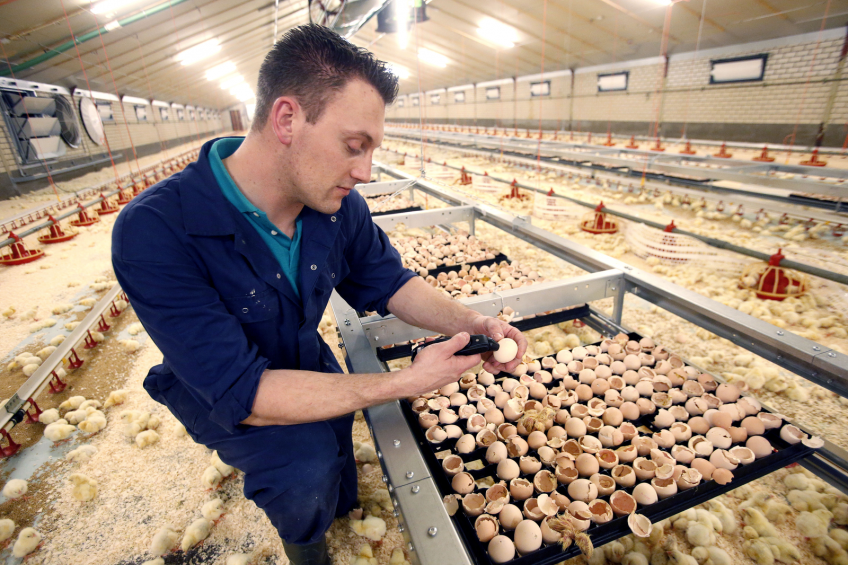Hatching environment can impact whole broiler life

Bringing the actual hatching of broiler chicks to the farm after incubating the eggs for 18 days in the hatchery puts a halt to transporting live animals and improves welfare. Furthermore a change of hatching environment can positively impact the health and production of the broiler during its whole lifespan.
By Pieter de Gouw, poultry specialist at the R&D department of Vencomatic Group
In on-farm hatching systems eggs are placed inside the broiler house at day 18 of incubation and are hatched in the same environment they will stay for the rest of their lives. This new approach to broiler farming eliminates transport of day-old chicks and enables the broiler chicks to access feed and water directly. Practical results in on-farm hatching systems indicate differences both in early life development and in broiler performance later on. Table 1 shows that mortality and FCR are lower and overall body weight and average daily gain are improved. Research, furthermore, showed that on-farm hatching reduced rejection rates with 33% and DOA’s at the slaughter house with 80%. This strong reduction in mortality, DOA’s, and rejection rates indicate improved broiler health in on-farm hatched broiler chickens. But why do broiler chickens in on-farm hatching systems perform better and seem healthier? Is it because of the early access to feed and water or are other factors playing a role in this? In order to answer this question we first have to understand the environmental conditions in commercial hatchers.
A challenging start
Commercial hatchers are inseparably linked to several challenging conditions for the chicks, such as: exposure to high dust levels, noise, formaldehyde treatment, chick handling, transport, and feed and water deprivation. Effects of these conditions on the health and development of broiler chickens are hardly described in literature. Currently Vencomatic Group together with Wageningen University are studying these conditions and their potential effects on subsequent health and
performance.
Dust
During incubation, the first chicks
generally hatch at day 19 of incubation. From that moment on, the percentage of hatched chicks gradually increases until about 95% has hatched at the end of day 20. The increasing density of hatched chicks results in rising levels of fine dust (PM10 i.e. dust particles ≤ 10 µm) since dust is released from the chicks as they dry up. The dust is then spread through the hatcher by high air speed. As can
be seen in Figure 1, the peak in dust concentration in circulating air, which coincides with the peak in the hatch window, reaches PM10 levels up to 3.5 mg/m3. After the peak of hatch, dust levels gradually decrease due to ventilation and deposition.
Dust particles in the PM10 size category are able to settle in the trachea and even in the lungs. Research on three week old broiler chickens showed that dust particles of 10 µm or smaller can enter the body via the lungs and settle in all parts of the body. This dust exposure at three weeks of age, furthermore, altered the immune response, resulted in a heavier and bigger heart, and reduced growth rate with 30 grammes per day in the first days after exposure. Recent research indicates that dust exposure during the hatching phase also affects growth rate of broiler chickens in the first week of age.
Pathogens and disinfectant
Together with high levels of dust, high levels of pathogens are released. When contaminated eggs hatch, pathogens are released and spread, using the dust as a mode of transport. These pathogens find an ideal grower environment in the hatcher with a temperature of approximately 37°C and a relative humidity between 60 and 90%.
Pathogens are spread throughout the hatcher, again helped by the high air speed, resulting in high risks for cross contamination. In order to combat pathogens, disinfectant (still quite often formaldehyde) evaporation is widely used during the hatching process. Formaldehyde is known to be a highly effective disinfectant. Formaldehyde, however, also affects the cilia and epithelium of the airways of the chickens, which reduces their capacity to filter out dust particles and creates possible entry routes for pathogens. Recent studies show that exposure to formaldehyde negatively affects body weight gain in the first week of a broilers’ life.
Chick handling and transportation
At day 21.5 of incubation the broiler chicks are collected from the hatcher. After chick collection, chicks are separated from unhatched eggs and empty egg shells, counted, vaccinated, and transported to the farmer. After going through this process, the broiler chicks are put in crates and transported to the broiler farm.
This transition from hatcher to broiler house possibly causes stress and affects the broiler chicks. Effects of transport on day-old chicks and its’ consequences in later life is, however, an understudied subject. The chickens are kept without feed and water between hatching and placement in the farm. Several researches showed that this delay in first feed and water intake has a major and long lasting impact on the development of the intestines and the immune system.
Consequences for health and production
The conditions in commercial hatcheries, appear to affect early-life development with long lasting consequences. In on-farm hatching systems, chicks are not subjected to this set of conditions during hatching. The combination of direct access to feed and water, relative low exposure to dust and pathogens, and no transport seems promising in our approach to improve both health and performance, in early life and through the whole cycle.
Field trails show that on-farm hatching can do without the use of antibiotics. On-farm hatching, therefore, is a promising solution to boost broiler health and reduce antibiotics use.













